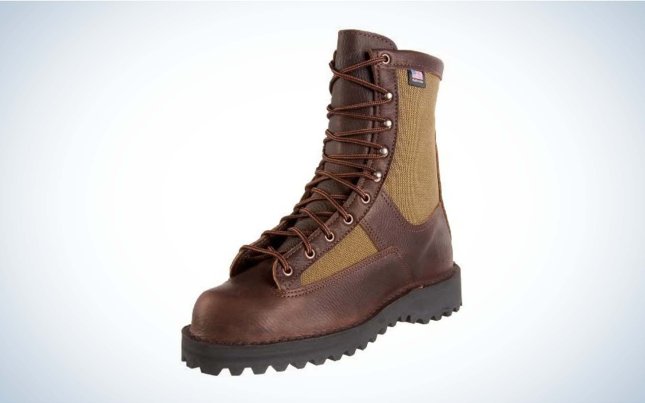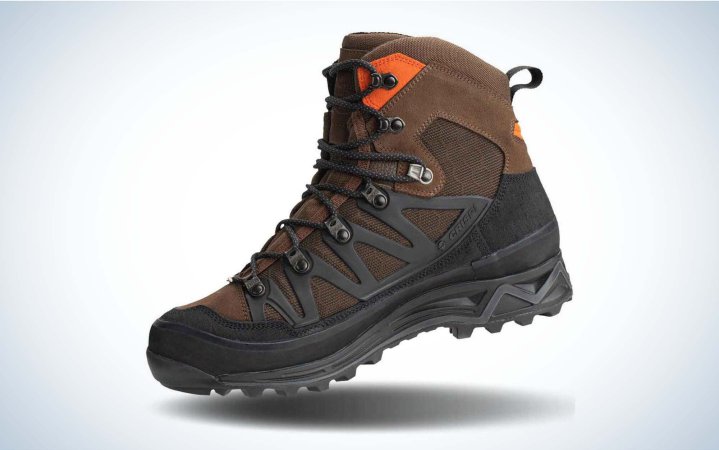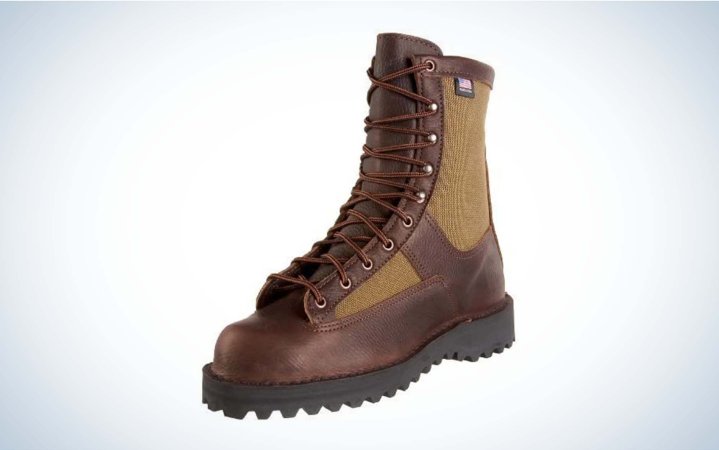We may earn revenue from the products available on this page and participate in affiliate programs. Learn More ›
As an upland bird hunter, I don’t mind dropping cash on a pair of well-made hunting boots. I’ve hunted upland birds for more than 25 years, and I’ve worn through my fair share of treads. One lesson I’ve learned is that cheap or ill-suited boots can derail your hunt faster than anything. Don’t let a subpar pair of boots be the reason for cutting your hunts short this season.
Whether you’re chasing birds on the prairies or across rugged mountain sides, make sure your boots are best suited for the terrain and conditions. To help you do that, I’ve compiled a list of the best upland hunting boots to keep you in the field longer no matter where you hunt.
- Best for Western Hunts: Crispi Wyoming II GTX
- Best Multi-Purpose: Danner Grouse
- Best Casual: Irish Setter Wingshooter
- Most Comfortable: Meindl Vakuum Hunter
- Best for Late Season: LaCrosse Alphaburly Pro
How I Chose the Best Upland Hunting Boots
To test these boots and the best upland hunting pants, I spent this summer hiking in them through a variety of terrains, especially where I’m likely to encounter birds this fall. By covering terrain I’m likely to hunt, I was able to give an assessment of how each of these boots would perform.
Best Upland Hunting Boots: Reviews and Recommendations
Best for Western Hunts: Crispi Wyoming II GTX
Best for Western
Crispi Wyoming II GTX
Why It Made the Cut
Crispi’s Wyoming II GTX boots provide serious comfort, support, and breathability in a reasonably lightweight boot that’s perfect for chasing birds in rugged terrain.
Key Features
- Weight: 3.9 pounds (size 10)
- Gore-Tex lined
- Non-insulated
- Shock absorbing Vibram Sole
- Removable Crispi Air Mesh insole
Pros
- Comfortable
- Substantial ankle support
- Minimal (less than 5 miles) break-in
- Waterproof and breathable
Cons
- Expensive
Product Description
Besides your trusty bird dog or your best shotguns for bird hunting, Crispi’s Wyoming II GTX boots will be your best friend in the field. These boots provide plenty of comfort and support for your feet and ankles even for those days when you log double digit miles. I immediately noticed how comfortable these were when I first tried them on. As far as a break-in period, these were good-to-go after I wore them around town for a day. Even when I did break them out on the trails, I was impressed with their breathability, especially on the hottest summer days. After several hikes with them, my feet didn’t sweat excessively, and I didn’t notice any hotspots.

It is worth noting that these boots have a fairly stiff sole, which I prefer in terrain with drastic elevation changes. But if you’re hunting gently rolling prairies or fairly monotonous terrain, these might be unnecessary. The Wyoming II GTX boots come with a steep price tag, but if you cover plenty of rugged ground, these are hard to beat.
Best Multi-Purpose: Danner Grouse
Best Multi-Purpose
Danner Grouse
Why It Made the Cut
The Grouse boots from Danner have the quintessential fit and feel of an upland hunting boot but still provide support and comfort for long days in the field.
Key Features
- Weight: 3.87 pounds
- Full-grain leather and cordura denier nylon upper
- Gore-Tex lined
- Danner Bob outsole
- Uninsulated
Pros
- Waterproof
- Comfortable
- Great traction
Cons
- Expensive
- Longer break-in
- Slightly narrow footbed
Product Description
With a name like Grouse, these boots set high expectations for me. And they delivered. The impressive grip on the Bob outsole provided great traction while I climbed steep, rocky sidehills. And the durable, full-grain leather works great in a variety of conditions, and it should also expand the life of these boots as well.
Danner advertises that these boots run narrow. My feet are stuck between too wide for some regular width boots and not wide enough for most “EE” footbeds. I chose the regular footbed for these, and they were a tad tight when I first put them on. After several mountain miles they stretched slightly, but they’re still a bit narrow. If your feet lean more towards a wider footbed, go with the “EE” width for these.
Best Casual: Irish Setter Wingshooter
Best Casual
Irish Setter Wingshooter
Why It Made the Cut
An upgrade on Irish Setter’s classic upland boot, the Wingshooter is completely waterproof, and the 9-inch version gives excellent ankle support. Best yet, these stylish boots look great whether you’re trying to flush a bird or grab a casual dinner.
Key Features
- Weight: 4 pounds
- Waterproof
- Steel shank
- Removable insole
- Uninsulated
Pros
- Durable, abrasion-resistant leather
- Affordable
- Doubles as a great work boot
Cons
- Substantial break-in process
- Gets steamy on long walks
Product Description
There’s a reason upland bird hunters have been wearing these boots in the field longer than I’ve been alive. The Wingshooters are an affordable, comfortable, and durable upland hunting boot. While all-leather, waterproof boots have their advantages, they can struggle with breathability. Unlike the Crispis I tested, these boots made my feet constantly sweat on warm days. You’ll definitely want to save these for late season roosters, especially if you get the insulated version. But in reasonable temps, these boots will do just about everything you ask of them and more.

Most Comfortable: Meindl Vakuum Hunter
Most Comfortable
Meindl Vakuum Hunter
Why It Made the Cut
The Air-Active insoles in Meindl’s Vakuum Hunter boots mold to your feet for an extremely comfortable fit.
Key Features
- Weight: 3.87 pounds
- Gore-Tex lined
- Nubuck leather upper
- Air-Active insoles
- Vibram Alpin outsoles
- Uninsulated
Pros
- Extremely comfortable
- No break-in necessary
- Waterproof
Cons
- Slightly stiffer outsole
Product Description
The Meindl Vakuum Hunter boots are the most comfortable boots out of the box that I’ve ever tried on. They required a zero break-in period for me. I just put them on and didn’t have any issues or noticeable hotspots even after trekking several miles in them. If comfort keeps you in the field longer, these are the best upland hunting boots for that purpose.
The Vakuum Hunters feature an aggressive Vibram Alpin outsole that provides great traction when you’re pursuing that next covey in steep country. Like the Crispi Wyoming II GTX boots, these feature a slightly stiffer outsole than you might need if you’re hunting primarily flat terrain. The Vakuum Hunters come with a hefty price tag, but these boots are so comfortable you’ll be lacing them up to chase other game too.
Best for Late Season: LaCrosse Alphaburly Pro
Best for Mud and Snow
LaCrosse Alphaburly Pro
Why It Made the Cut
For those cold, late season hunts, LaCrosse’s Alphaburly Pros will keep your feet dry and toasty.
Key Features
- Weight: 5.2 pounds
- EVA midsole
- Embossed neoprene liner
- Insulated and non-insulated options available
Pros
- Comfortable
- 100 percent waterproof
- Aggressive traction
- Adjustable gusset
Cons
- Not the best for all day hunts
Product Description
LaCrosse’s Alphaburly Pros are my go-to rubber hunting boots for chasing wily roosters in everything from swampy cattail bottoms to snow drifted plains. These boots come in various insulation options that range from uninsulated to a whopping 1600 grams of Thinsulate. So, whether you just need to keep your feet dry or from going numb, there’s an insulation option to fit your needs.
The Alphaburly Pros might seem like overkill, but a lot of other upland hunting boots might not cut it when you’re trudging through ankle-deep snow. I definitely leave these at home if temps and conditions are mildly nice, and their weight makes them less than ideal if you plan to cover a ton of ground. But for the die-hards who want to kick up a few no matter the conditions, these boots can make sure you don’t miss any days in the field.
Things to Consider Before Buying Upland Hunting Boots

Where and when you hunt plays an important role in determining which boots best fit you. A long day chasing birds will quickly tell you if you have the correct footwear. To make sure you don’t learn that the hard way, here are a few things to consider.
Terrain
This might be the most important factor to help you find the best boot for your needs. I hunt upland birds across the rugged mountains of the West. My main concern is support and breathability because I know I’m going to cover several miles on any given hunt. A lightweight, breathable boot like Crispi’s Wyoming II GTX provides plenty of support, yet they won’t make my feet sweat like a heavily insulated boot.
But if you hunt pheasants and quail in the Midwest plains, you can probably get away with the Irish Setter Wingshooters or a pair of rubber boots like the Alphaburly Pros.
Insulation
If you hunt the West or early season birds, an uninsulated or low insulation number will suffice. But for late season roosters or frigid temps, consider an insulated or rubber boot that will keep your feet dry and warm.
Cost
The truth is, good boots aren’t cheap. If you have the extra coin, solid boots are a great investment, and you’ll save money in the long run instead of buying cheaper pairs that don’t last long. Even worse, cheap boots can ruin a hunt. It’s also worth having multiple pairs, so you’re covered for a variety of weather conditions, especially if you hunt various regions of the country.
Read Next: The Best Hunting Boots of 2023
FAQs
Technically, no, upland boots don’t need to be waterproof. However, I prefer waterproof boots just in case I encounter unexpected weather or terrain conditions. Upland birds, especially pheasants, seem to always lead me through bogs of standing water. Waterproof boots also come in handy when you are walking through brush and shrubs that are still wet from the morning dew. Once your feet get wet, you open the door for a multitude of foot problems, all of which are uncomfortable and generally end your hunt early.
How and when you hunt birds should determine the level of insulation you need for your upland hunting boots. When I hunt birds I am typically piling on the miles, so I almost always use an uninsulated boot to let my feet breathe as much as possible. If you primarily hunt the late season when temps regularly dip below freezing, then it is worth having a pair of boots with some insulation in them, especially if you don’t have a ton of miles to cover.
Both lightweight and heavyweight upland boots have a place, you just have to decide what works best for you. I like to have a pair of both for different conditions. Generally, I prefer lightweight boots that do not impede my movement when hiking. Heavyweight upland boots are ideal for short hunts on level terrain or when I’m dealing with unfavorable elements.
Final Thoughts
When you’re buying a pair of the best upland hunting boots, it’s best to try them on if you can. Pick the one that can handle the conditions you hunt most and provides you with maximum comfort. Those two factors are a recipe for long, memorable hunts, and if your boots can give you that, they’ve outdone their job.
- Best for Western Hunts: Crispi Wyoming II GTX
- Best Multi-Purpose: Danner Grouse
- Best Casual: Irish Setter Wingshooter
- Most Comfortable: Meindl Vakuum Hunter
- Best for Late Season: LaCrosse Alphaburly Pro








